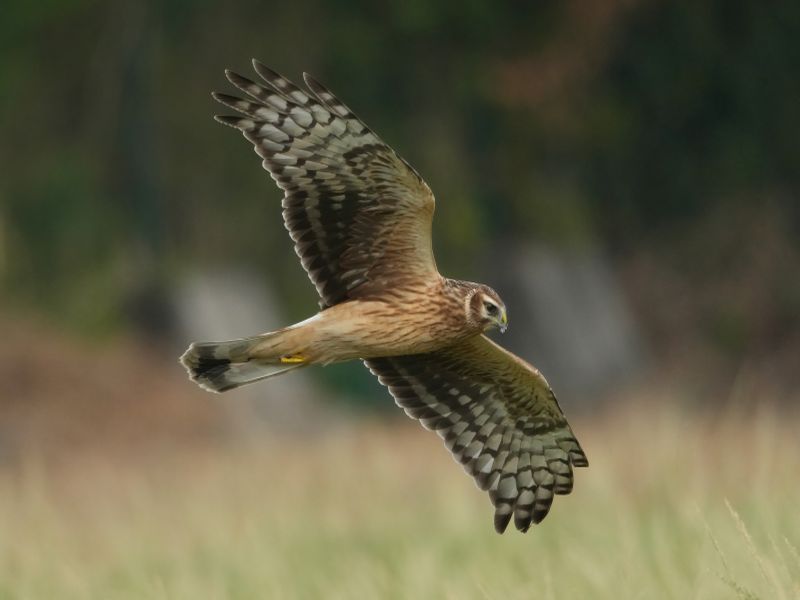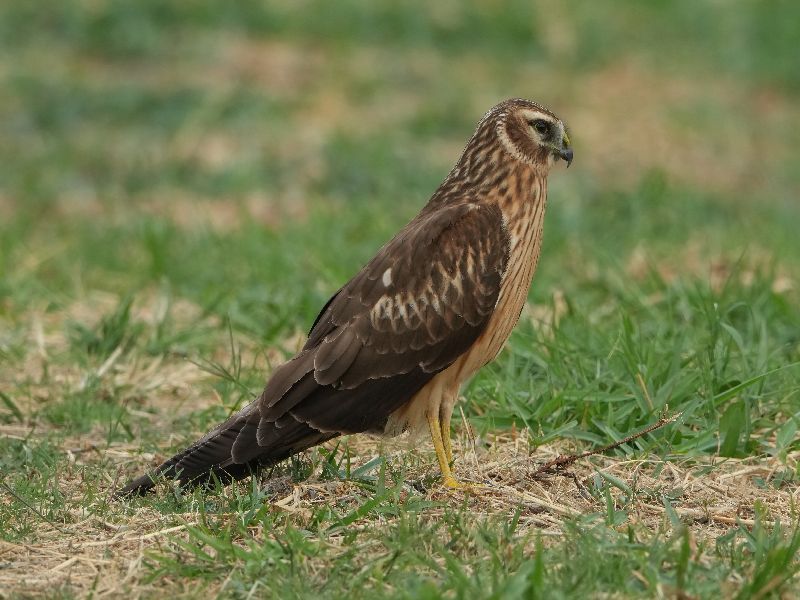Hen Harrier Circus cyaneus 白尾鷂
Category I. Accidental.
IDENTIFICATION

Dec. 2025, Paul Leader. Juvenile.
42-50 cm. In all plumages has a white rump. The adult female, which averages about 10% larger but 50% heavier than the male, is dark brown above, pale below with dark streaks and has obvious dark bands along the underside of the primaries and secondaries and on the tail. The juvenile is similar to the female but has a pale area on the upperwing coverts, white tips to the greater coverts, ochre underparts and underwing coverts and dull iris.

Dec. 2025, Paul Leader. Juvenile.
Additional features ruling out other female or juvenile regional harriers are five visible primary ‘fingers’, a white patch more or less encircling the eye surrounded by a brown facial disc behind which there is a thin, pale collar encircling the head, brown streaking on the breast and heavy dark banding on the underside of the secondaries, with the two inner bands continuing as dark bands across the inner primaries.
Adult male mostly uniform greyish above with a dark grey band along the rear edge of the secondaries, blackish primaries and a white rump. Underwings are white with broad greyish trailing edge to secondaries and inner primaries and black wing tips. The immature male has a browner mantle and duskier upperwings with a more diffuse grey band near tips of both secondaries and primaries.
VOCALISATIONS
Usually silent away from breeding grounds, but the following call was recorded from a bird going to roost.
DISTRIBUTION & HABITAT PREFERENCE
The sole record occurred at Mai Po NR.
OCCURRENCE
There is one record: a juvenile female from 31 December 2018 to 15 February 2019.
BEHAVIOUR, DIET & FORAGING
No observations.
RANGE & SYSTEMATICS
Monotypic. Breeds from northwest Europe east across the Palearctic to northeast Siberia and Kamchatka, south as far as Ukraine and northeast China, with disjunct populations in the Pyrenees and northeast Kazakhstan. Winters as far south as northwest Africa, Oman, northern India and northern Indochina, with vagrants further south (Orta et al. 2020).
In China it breeds in the northeast and far northwest, and is a winter visitor to the southern provinces south of the Chang Jiang, including Hainan, Taiwan and Dongsha Is. Although regarded as very common at Shantou in the early 1890s (La Touche 1892) and fairly common around Canton in the 1910s (Mell 1922), there are relatively few recent reports. In China breeds in the northeast and northwest and winters in south China according to Liu and Chen (2020); however, it appears to be rare this far south in China.
CONSERVATION STATUS
IUCN: Least Concern. Population trend decreasing.
La Touche, J. D. D. (1892). On Birds collected or observed in the Vicinity of Foochow and Swatow in South-eastern China. Ibis 1892: 400-430, 477-503.
Liu, Y. and Y. H. Chen (eds) (2020). The CNG Field Guide to the Birds of China (in Chinese). Hunan Science and Technology Publication House, Changsha.
Mell, R. (1922). Beitrage zur Fauna sinica. Archiv fur Naturgeschichte 88 (10): 1-100.
Orta, J., G. M. Kirwan, P. F. D. Boesman, J. S. Marks, E. F. J. Garcia, and C. J. Sharpe (2020). Hen Harrier (Circus cyaneus), version 1.0. In Birds of the World (J. del Hoyo, A. Elliott, J. Sargatal, D. A. Christie, and E. de Juana, Editors). Cornell Lab of Ornithology, Ithaca, NY, USA. https://doi.org/10.2173/bow.norhar1.01

